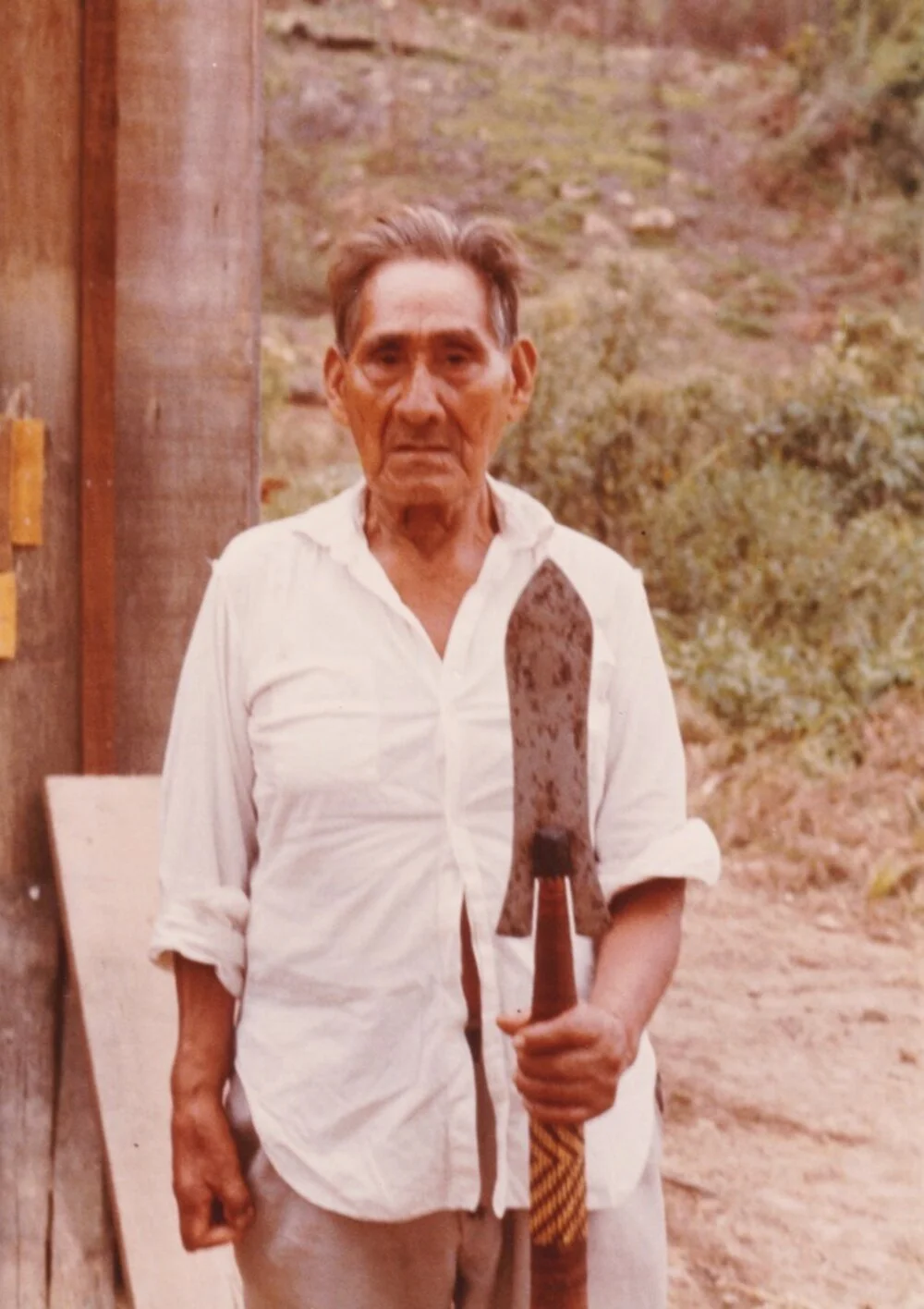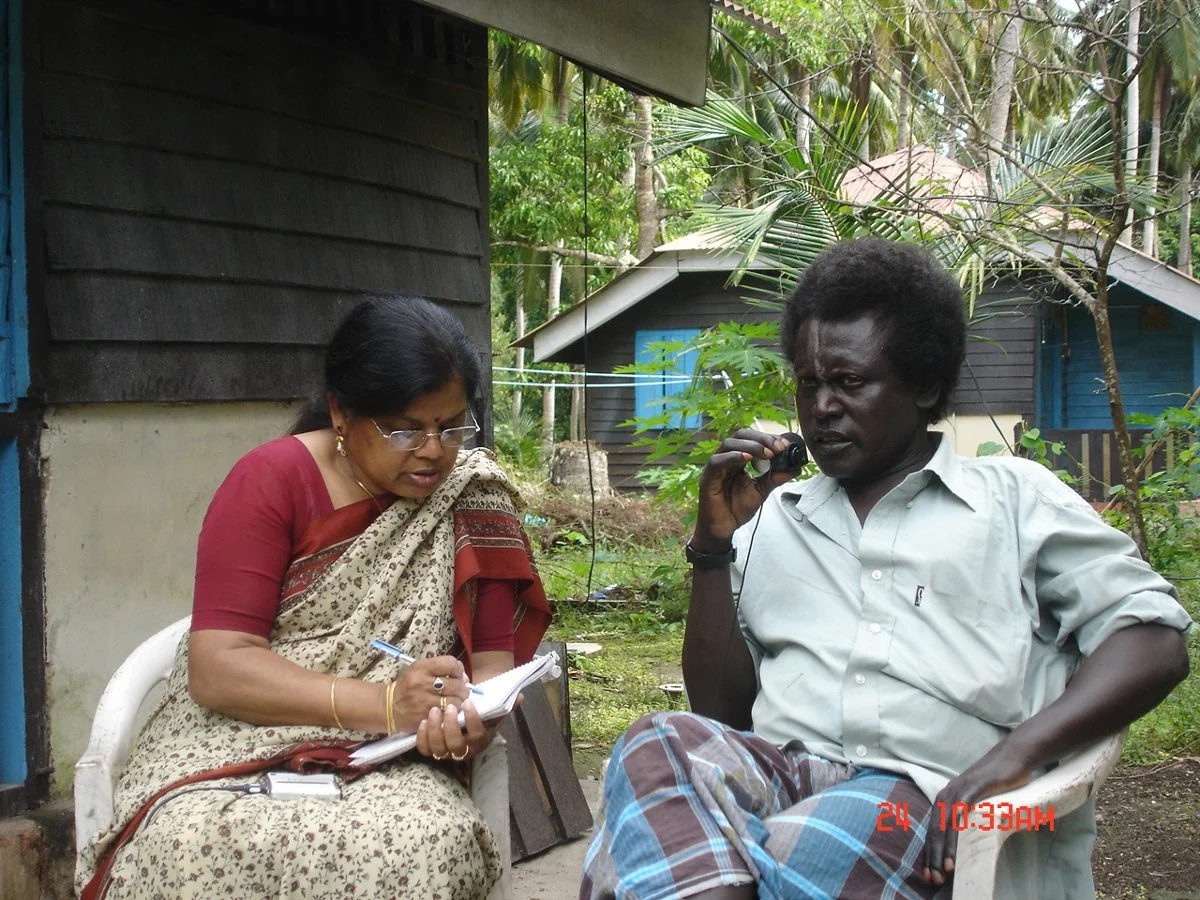STORIES
Mani
A MANI LAMENT
by Tucker Childs
Portland State University
Historian Morlaye Boyo Keita (left) and interviewer Foday J. D. Kamara (right), both now deceased
pelɔ mfɔkɔ ka, lɔmɔ kɔnya?
If you leave from here, where will you go?fɔ n pɔŋun wɔŋ ko nyɛlɛ,
Unless you jump into the sea,lɛ biyɛn fɛrɛ.
there is no other place to go.mani dilan lɛi pɛ ke ki lɛ yema den.
The Mani culture that you see here will disappear.(mb 5/15/05; jd 8/10/06)
If you do escape, where will you go? You have to plunge into the sea! You have no other recourse. The Mani culture is doomed to disappear.
– Morlaye Boyo Keita; Palatougou, Guinea (15 May 2005)
This quote comes from a history of the Mani people, as recounted by the renowned Mani historian Morlaye Boyo Keita. He was talking about the way in which the Mani people were forced off their ancestral lands by the advancing Soso interlopers (a parallel situation existed further south with pressure from the Temne). At this point the Mani could go no further – their backs were up against the sea and they were being overrun even there.
Excerpts from: Childs, G. Tucker. 2011. A Grammar of Mani. New York and Berlin: de Gruyter.
Excerpt 1.
Speakers of the Mani language today occupy scattered, remote, and isolated pockets in the Samu (spelled “Samou” in Guinea) region straddling the border on the coastal plain of Sierra Leone and Guinea. No villages in Guinea can be found in which Mani is the dominant language, although distinct sections and sometimes entire towns are ethnically Mani. In Sierra Leone, however, Mani remains a sometimes daily language in a small collection of geographically close villages around Morebaya in Kambia District. These are the remnants of a Mani kingdom which once held suzerainty over the entire Samu region, stretching inland from the sea in a coastal band from Freetown to Conakry (north beyond Conakry to Baga country according to Moity 1957). Over time, however, the kingdom dissolved and contracted. The Mani lost ground in successive generations to more powerful neighbors and retreated to peripheral and isolated enclaves.
Excerpt 2.
In the same town a teacher in the local school made a revelatory and not atypical comment. He said the Mani hide their language, “They are very discreet.” We also observed many younger speakers who did not speak Mani greet members of the research team in Mani using a mocking tone. Nonetheless, the Mani of Kigbali were flattered by the attention being paid to them and their language. For example, when I took pictures of two elderly female informants, women at a woodworking shop next door yelled at me to take their picture, too, since they, too, could speak Mani.
An anecdote first reported elsewhere (Childs 2003b) illustrates the low esteem in which the language is held by people on the island of Kabak – even ethnic Mani. Alia Fadega, a citizen of the village of Kakende, when questioned about the use of Mani in his town, told us that he had heard only “the old people (les vieux)” speaking Mani. Quite revelatory was to whom he heard them speaking: to their dogs; and sometimes, he continued, his grandfather would go to a large kapok tree (fromager) behind the village and talk to “the devil (au diable, i.e., les fétiches).”
Nonetheless, there is some deep-seated and even fierce attachment to the language. An old man in Moribaya, Sierra Leone, said the Soso liked to argue overmuch; they were hardheaded and stubborn people (tɔ̀ntùbùlìyá). He refused to speak Soso with anyone and would reply in Mani even if spoken to in Soso. (This individual was very much like an individual in Nancy Dorian’s fieldwork, who would also reply in Gaelic when spoken to in English (Dorian 1973:437-38).
In Caton (Guinea), the research base for the 2004–06 project, we made some recordings of songs sung by women and a folk tale. One woman who asked to be recorded issued an unsolicited plea in the recording for the maintenance of Mani and chastised Mani women for not teaching the language to their children.
A less defiant comment was made by Momoh Seki Camara of Yankanya (“Yankaya” on some maps), near the road approach to the isle of Kabak in Guinea. He said that he and his (first) wife speak Mani between themselves but none of his (20) children speak it at all (his other three wives are all Soso). Both his parents and all their parents were Mani speakers. I asked him what he thought about his language disappearing; he looked at me rather despondently and said that he deeply regretted its passing.
These anecdotes (and many others) reveal that there is at least some residual fondness if not enthusiasm for the language. It is such sentiments that motivated the larger study forming the source for the data here. Whether these feelings will translate into dedicated efforts at language preservation is uncertain at best.
Excerpt 3.
Verbs have little morphology. Tense, mood, aspect, and polarity (TMAP) are generally shown by means of free morphemes, which both precede and follow the verb. Tone and segmental changes may also mark verbal distinctions. Mani has at least five fairly unproductive verb extensions, verb suffixes which affect argument structure.
Mani has a limited number of prepositions rather broad in meaning, but often used in conjunction with semantically narrower postpositions, which further specify meaning.
Tucker Childs with M'ma Yelio Camara, who described herself as Tucker Child's "country wife" (deceased)
Most words functioning as adjectives in Mani are likely derived from verbs, although the directionality of derivation is not straightforward. The few words that function only as adjectives are relatively broad and basic in meaning, conveying such universal concepts as ‘good’, ‘large’, and ‘white’. The adverb class is similarly restricted but semantically supplemented by ideophones. This latter highly idiosyncratic word category has a marked phonology as compared to the matrix language, and contains words that often underscore an action or sensation (see Childs 1994a).
Mani is basically a head-initial language, both syntactically and semantically: dependent elements generally follow those on which they are dependent.
Verbs always follow subjects and objects follow verbs, although in some constructions, object pronouns are found before the lexical verb and after an auxiliary, as is not uncommon among the Atlantic languages, a partial instantiation of the S-Aux-O-V syntagm (Childs 2005).
With regard to movement rules, a focus construction fronts an item of focus and marks the focused item with a following element, usually a pronoun. Yes/no questions require a final marker; Q-word questions do not. In the latter type of question, the question word appears at the beginning of the question with a gap in the place where the questioned element would appear. Other sentence types are marked by intonation with no movement. Relative clauses are introduced by a pronoun and end with a relativization marker. They typically contain an unmarked gap identical to Q-word questions, although resumptive pronouns also occur.
The most striking fact about the language, however, from a field investigator’s perspective is its variability, its variability across speakers and even within a single speaker. Only a few hundred speakers use Mani as their primary language, and no speakers are monolingual. Choosing what could be presumed to be the most common or shared form often proves to be problematic. That Mani is about to disappear has undoubtedly had severe repercussions for all parts of the grammar, as well as for its analysis.
Mani is basically a head-initial language, both syntactically and semantically: dependent elements generally follow those on which they are dependent.
CONTINUE READING STORIES
















